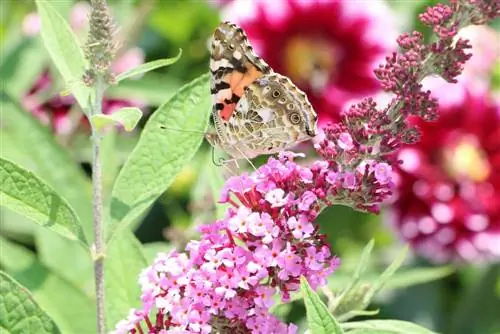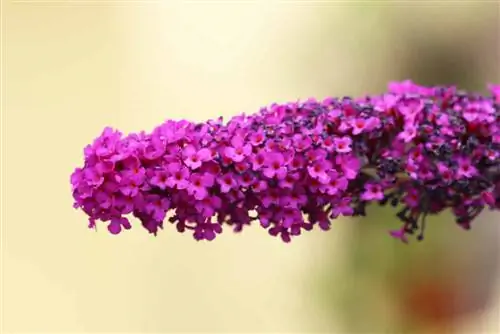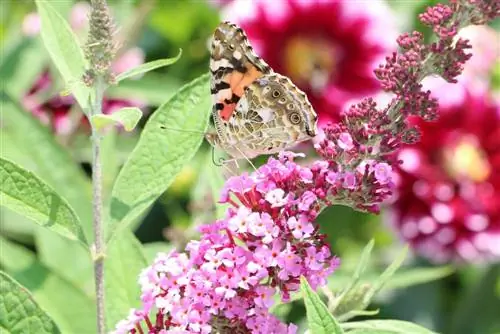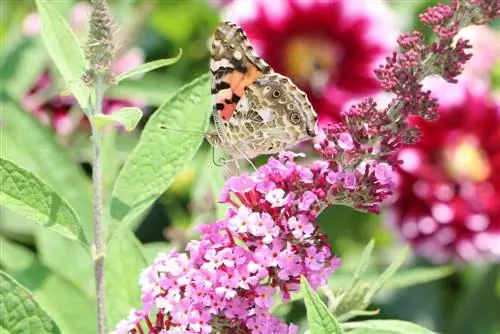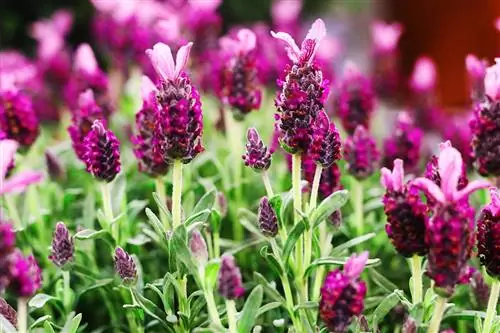- Author admin [email protected].
- Public 2023-12-17 03:39.
- Last modified 2025-01-24 12:45.
A lilac that is loved and visited by so many butterflies fully deserves its name butterfly lilac. It is a living invitation to these winged creatures. As soon as it blooms, they buzz around it. This sight is reason enough to give it a place in the garden. After all, nature is not just there for us humans.
Growth and flowering
The shrub from the figwort family easily reaches a height of two meters. Buddleja davidii easily grows up to one meter wide. The butterfly bush is regularly pruned heavily, but the pruning does not diminish its appearance in the long term. It sprouts well again. After just a few weeks of growth it has grown back into a beautiful bush. Flower panicles form at the ends of the branches and bloom from July onwards. The flower dance delights until the first frosts. Depending on the variety, the buddleia blooms in white, yellow, pink or blue-violet. It is known by many names among amateur gardeners: common buddleia, butterfly bush or lilac spear. Buddleia is already available from us in more than a hundred types. If cared for well, it will live for at least ten years.
Location
The buddleia feels right at home in sunny places. An edge location with enough space on the right and left where he can develop unhindered is ideal for him. It forms a beautiful privacy screen at the edge of the garden, but it also looks great as a solitary plant in the middle of the bed. It loves warmth, but adapts to partially shaded places. Even with modest doses of sun, it unfolds its full magic. As a flowering shrub, you really shouldn't expect it to have full shade. It would be a shame if it only offered a pitiful image of a butterfly bush. He is welcome to have green trees behind him as long as the other side remains free and gets plenty of unhindered sun. Its strong flower color stands out even better against the rich green background. Here the shrub is also somewhat protected from wind. Its new branches are thin and can be easily snapped by strong winds.
Soil texture
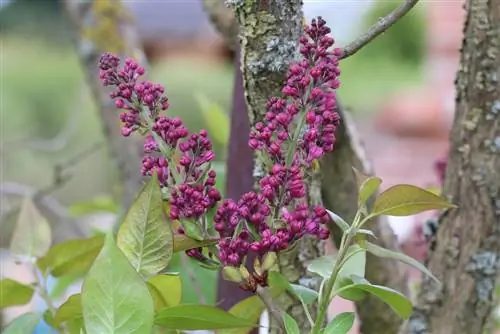
You should offer your buddleia optimal soil conditions so that it can thrive optimally. Don't worry, you can find a place like this in any garden or set it up accordingly with a little work. If the soil is not ideal on its own, soil improvement measures can work wonders. The soil in which the butterfly lilac develops particularly well is light and permeable. It should also be dry, as the lilac spear neither needs nor likes excessive moisture. The annual flower mass relies on sufficient nutrients, so the soil should not be barren in this regard. Luckily, you can also help with plenty of compost. It tolerates acidic and calcareous soils as long as they are not moist and heavy.
Pouring
The buddleia likes dry soil, but still needs regular water during its vegetation phase in order to achieve the enormous increase in branches, leaf mass and, last but not least, flowers in record time. In the summer months, its soil must always be moist. However, standing water must be avoided. If the soil is permeable, this is easy to maintain. A little sand mixed in when planting prevents waterlogging later. This lilac likes hard water. If you pamper him with rainwater, you should first mix it with a little lime to meet his needs. Rainwater is not particularly calcareous in itself. After planting, you need to pay even more attention to watering the lilac until it is properly rooted.
Fertilize
Even if the roots of the butterfly lilac find plenty of nutrients in the surrounding soil, light fertilization is recommended. Especially if the lilac has been in this location for a few years, it will have already drawn a lot of nutrients from the soil. The soil should be enriched with nutrients again in the spring after pruning. A fertilizer containing nitrogen is optimal for this flowering shrub.
Propagate
Buddleja davidii is very easy to propagate in summer. All that is needed are well-developed, annual shoots of the plant. Of them, only the tip is used, which should be about 15 cm long. Any flowers present are removed with secateurs, as are the lowest pairs of leaves. Two further measures promote root formation:
- shortening the remaining leaves to about half
- Using a special rooting powder
After the root-promoting treatment, you can plant the branches immediately.
- Fill a flower pot with a mixture of sand and peat.
- Put the branches a few centimeters deep into the soil.
- Water the cuttings well.
- Put a glass container over the cuttings to increase the heat.
- Place the planter in a bright but sun-protected place.
- Remove the glass regularly to ventilate. Otherwise, mold can quickly form due to high humidity.
- Water the cuttings so that they are consistently moist but not wet.
- When the cuttings have rooted, which will be the case around autumn, the small plants can be planted out in the garden.
- Give the young plants a suitable location and prepare the soil.
- Lay brushwood or leaves around the planting site. Young plants need this layer in the first three years of life in order to survive the winters undamaged.
Plants

It's best to buy a butterfly plant in spring and plant it in the garden straight away. It comes in a suitable location in well-loosened soil that has previously been enriched with compost. The young plant is kept moist until it grows. Homegrown plants from cuttings can be planted in the garden in the fall. It is also possible to wait until next spring. In this case, the young plant should overwinter in its winter quarters. The butterfly bush also likes to reproduce itself through its seeds. If you want to prevent “wild” sowing, you should cut off and dispose of any dead flowers in good time.
Bucket keeping
A butterfly lilac is simply beautiful. Once you've fallen in love with this colorful shrub, you won't want to be without it. Not even if he can't be offered a garden. This wish can be fulfilled with a balcony space and a sufficiently large bucket. In winter, a cool hibernation room must be available. Unlike many plants, the butterfly lilac is not poisonous and can therefore be cultivated close to home by families with children or pets without hesitation.
Cutting
The buddleia grows more beautifully and blooms more magnificently if it is cut regularly. Although pruning is not mandatory, it should be done regularly for these reasons. If there isn't time for that, it doesn't have any bad consequences. The cut can be done next time. You don't have to wait long for this, because the butterfly lilac can be cut in winter and summer. Winter pruning primarily serves to rejuvenate the plant, while the effects of summer pruning can be clearly seen on the flowers. Regardless of when the cut is carried out, a few basic rules should be followed:
- cut off dead branches at the heel
- sick branches also need to be cut at the base
- cut diseased plant parts immediately, regardless of time
- sharp and cleaned tools are a requirement
- variable cutting heights enable a denser crown
- the fewer eyes remain, the denser the lilac grows
- Radical cuts close to the ground are possible
- Radical pruning curbs growth, the abundance of flowers remains
Winter cut
When pruning in winter, old branches have to make room for new growth. That's why pruning takes place in the cold season, before growth begins.
- ideal period is November to March
- on frost-free days
- the day can't be sunny
- all branches are cut back
- Short last year's shoots 5 cm into the old wood
- on older bushes, all old branches should be removed
Tip:
In winter, a lilac bush that has become too powerful can also tolerate radical pruning.
Summer cut
A correctly carried out summer cut prolongs the fragrant enjoyment of flowers. The bush can be shortened by half around May or June. The flower then appears at a later point in time, but on the other hand it lasts longer. A butterfly bush pruned in this way can exude its colorful charm well into October. A second option for summer pruning is available as soon as this butterfly magnet blooms. In the months of June and July, all spent panicles should be consistently removed. The individual branches are shortened by half. Under optimal conditions, this cut is followed by a second flowering period. Depending on the weather, this can be expected in August or September.
Tip:
Do not put spent panicles in the compost heap. The seeds can survive there well and later sow themselves in undesirable places when the ripe compost is spread in the garden.
Alternate Buddleia
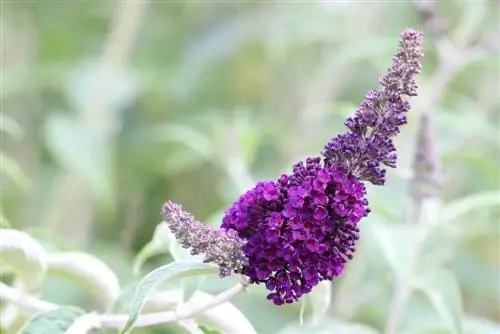
This variety is easily recognized by its overhanging growth. It blooms on two-year-old shoots, which is why the cut has to be carried out differently here. After flowering, the plant is only thinned out slightly. Older shoots are then cut directly at the base. Beyond that, no further cutting measures are required. If severe pruning is necessary for any reason, you will have to forego the next round of blooms.
Pests
The buddleia is not only irresistible for butterflies. Green bugs also like this shrub. But unlike the pretty butterflies, the green bugs are not attracted by delicious nectar. They cause direct damage to the buddleia. And unlike butterflies, they are hardly noticeable to the human eye. Their green color makes them invisible creatures with equally green leaves. Caterpillar flies and birds, for their part, have this pest on their menu. They support the gardener without being asked, even before he or she has even noticed the infestation. If the diligence of the natural bedbug killers is not enough, the owner of the buddleia can intervene to help. There are some natural methods available to combat this pest. Wielding a chemical club here is unforgivable for nature. Just try this way:
- Make soft soap lye
- spray on the affected areas
- spray early in the morning
- repeat after a week
- alternatively or if soft soap is not enough: treatment with neem oil,
- also called neem oil
- acts stronger than soft soap
Tip:
Neem oil is available in gardening stores and pharmacies, among other places.
Diseases
Narrow-leaved buddleia is caused by a virus. The leaves curl and show yellow spots. If you discover these signs on your lilac plant, you and the butterflies will unfortunately have to say a sad goodbye. This virus cannot be effectively combated, the Buddleja can no longer be helped. The entire plant must be discarded. Of course not in the compost, where diseased plants never belong. The residual waste bin is the right place to go.
Wintering
Every spring the butterfly lilac sprouts again and blooms on these new shoots. It therefore does not require any major protective measures in winter. An exception are young plants that have not been outdoors for long. They haven't had enough time to become sufficiently hardy yet. But with additional measures they can get through the winter well. These should concentrate on the root area and protect the root ball from major frosts. Therefore, cover the ground with a thick layer of brushwood or leaves in good time in autumn. Buddleias kept in a pot can wait in a cool room for the coming spring.

